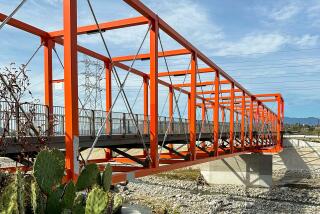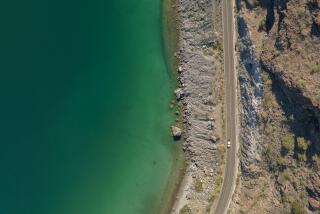Three Bridges Connect One Side of Spanish Town With the Other
- Share via
RONDA, Spain — We came to this bizarre Spanish town from Cadiz on a steep, winding road. It is a glorious drive, first through flat, dry, brown lands sprinkled, in the springtime, with wild red poppies among the scrubby brush.
Then at the crest of the first mountain range, the cliffs are barren and rugged and the drop into the second valley is frightening. But that meadowland is green and fertile and laid out in neat squares of planting, with many orange and olive trees.
The ascent continues and, on the mountains, suddenly an ornamentation of Siberian pines and cedar appears. My husband and I saw three small deer dash away into the great stand of trees.
About eight miles before Ronda is a turnoff to the village of Benaojan and the Caves of Pileta. It is a dreadful road; where it comes abruptly to an end an equally forbidding path winds up a cliff. A shepherd was there with his small, black-and-white dog, which went off at the shepherd’s high whistle to round up some stray goats on the rocks above.
Suddenly, sounds of whistling came from all over the valley, from other shepherds’ whistles, and the echoes followed us to the top of the path, where a locked gate prevents the passage of anyone into the caves.
Driver Must Honk
It is necessary to have the driver of your car honk his horn, so that the “keeper of the keys” can bring you the key to open the lock. These prehistoric caves are beautifully painted with colors that are still fresh and bright. On one wall, up high, is an extraordinary red fish. The climb and walk through the caves is difficult and tiring, but the rewards are great.
There is another green valley to cross, and then Ronda is before you, one of the most ancient towns in Spain. We took a tree-shaded road down to a white building with a roof of gleaming green tile. It is the Reina Victoria Hotel, and they cared for us for a happy, comfortable week.
If possible, reserve a room with a balcony that overlooks the verdant valley far below. Here the first glow of the morning sun touches the mountains, the Sierra Nevada. In the evening, far beyond the mountains, again gleams the last light, golden in the valley and fading to blackness in the shadows of the great rocks.
The hotel clings to the edge of the mighty gorge, El Tajo. The red rocks are sparsely covered with wild mustard flowers, topped by the manicured gardens of the hotel. These, in the early spring, are filled with bright red tulips and soft blue nemophila.
A handsome bronze sculpture of the German poet Ranier Maria Rilke stands staring toward the valley. The hotel has carefully preserved his room, with his photographs, letters and furnishings, as a museum; Rilke was a visitor who came often to stay for long holidays of walking and writing.
Coins Suggest Greeks
The first callers at the town appear to have been Greeks. Numerous coins found in the area bear designs drawn from Greek mythology. The history of Ronda was punctuated by invasions of Celts, Phoenicians, Carthaginians and Vandals.
Shortly after AD 305 the Romans established a small settlement. Nearby are many ruins, including a theater in a place known as Acinipo Viejo. Also, there are stones from the days of the Romans in the foundations of the Puente Viejo, a bridge built in AD 1616, 100 feet above the River Guadalevin.
Ronda became a part of the early trade routes and a resting place on the way to Africa or north to Cordoba. During the occupation by the Moors in AD 711 a bridge was built, Puente Arabe, 40 feet above the river and it was used heavily. Later it was completely rebuilt.
The Spanish retook Ronda in 1485 and the town began another bridge, the Puente Nuevo, completed in 1793, still in use along with the other two. This span stretches across the 600-foot-deep gorge. At three heights, Ronda’s three bridges form an impressive three-tier aspect.
It’s an easy stroll from the hotel to the new town or El Mercadilla, passing along by the tiny shops. One, in particular, has medals of all the Spanish military orders and a charming old gentleman who will show them with pride.
The elegant cathedral, Iglesia de la Merced, 1577, is nearby, next to a fine park, the Alameda de Jose Antonio. The day we walked through the park, babies were being pushed about in their prams or having the carriage held in place by a nanny’s sturdy shoe on the brake, while she sat to admire bright pink blooming trees.
From the wall at the edge of the park there is quite a different panorama of the great gorge and valley. We walked to the renowned Plaza de Toros. While some early smugglers and bandits were occupying the town, a select group of citizens built the great ring in 1748, not for bulls and fighting but for the practice of fine horsemanship.
They called themselves Real Maestranza dos Caballeria. The breeding and fighting of the bulls began later. Pedro Romero, the most famous of the great 18th-Century toreadors, was born in Ronda and fought his first bulls here. His birthday is still honored.
The gates to the bullring, for the spectators, are graceful iron grills. The delicacy of craftsmanship seems incongruous, considering the bloody show beyond. Large finely carved wooden doors are the entrance for the bullfighters. The arena of Ronda’s bullring is one of the oldest and largest in Spain. Goya often sketched here, and Hemingway came later to watch his friend, Antonio Ordonex, fight.
Around the town hall and the plaza the shops are full of modern gadgets, plastic bowls, sandals, motor bikes, christening dresses in fluffy white, and newly embroidered copies of old Spanish shawls in garish colors. Tourist shops have assorted key rings in the shape of bullrings, bridges and toreador dolls.
From this plaza you are almost upon the Puente Nuevo. The first sight of this giant span and its mighty parapets topped with lamps, followed by the next sight down into the gorge, is stunning. There is lacy grillwork along the top of the bridge and, as we moved, each flash of view through the grills offered another perspective of the gorge, as the light played in and out among the rocks. Far down in the dark, mysterious gorge the River Guadalevin glimmers like a slender thread of silver.
Tales are told of the architect of this bridge, who was so proud of his accomplishment that he had himself lowered in a box by ropes from the parapet, to inscribe his name and date on one of the stones. A gust of wind swept his hat off, as he hung perilously near his goal, and in his attempt to retrieve it he fell to his death in the depths of the gorge.
Stocked With Goods
Long ago, Jewish merchants were permitted to set up their stalls just beyond the end of the bridge, close by the Convento de Dominicos. The stalls were stocked with goods from caravans--silk, spices, gold, silver, gems and brocades brought from Africa and the East. The long-gone stalls have been replaced by an arcade of antique shops.
We saw a fine variety of items for sale--old glass, beads, silver jewelry with carnelian, old lace fans and tortoise-shell combs.
One of the shops had fascinating old maps, as well as notes of the 1750s acknowledging a monk’s receipt of food and oil for his parish. Beyond are narrow streets, framed on each side with walls of bougainvillea, surrounding white houses with red-tile roofs and a hospital founded by King Ferdinand and Queen Isabella more than four centuries ago.
On the way to the other bridges we saw the Arab baths and the thick walls of the town. The gateway to the first bridge, or Puente Viejo, is impressive and beautiful. Then the view of the second bridge, Puente Arabe, and the sight of the two of them together is exciting.
Again, the great, deep gorge El Tajo spanned by stones of such antiquity in the core of a town is overwhelming. Large blackbirds wheeled and floated on eddies of air, as they chose dark crannies for the night in the rocks of El Tajo.
We were glad that the small train that carried us from Ronda did not offer a final view of the bridges and El Tajo or we might not have gone away.
At the Reina Victoria Hotel we paid $78 a day for two with all meals. The cost of car, with driver, from Cadiz to Ronda was about $60, a train ticket from Ronda to Granada $7 one way. Ronda is 100 miles from Granada. The best season is February to April when the cherry, almond and apple trees are blooming.
For more information: Spanish National Tourist Office, 8383 Wilshire Blvd., Suite 960, Los Angeles 90211.
More to Read
Sign up for The Wild
We’ll help you find the best places to hike, bike and run, as well as the perfect silent spots for meditation and yoga.
You may occasionally receive promotional content from the Los Angeles Times.






